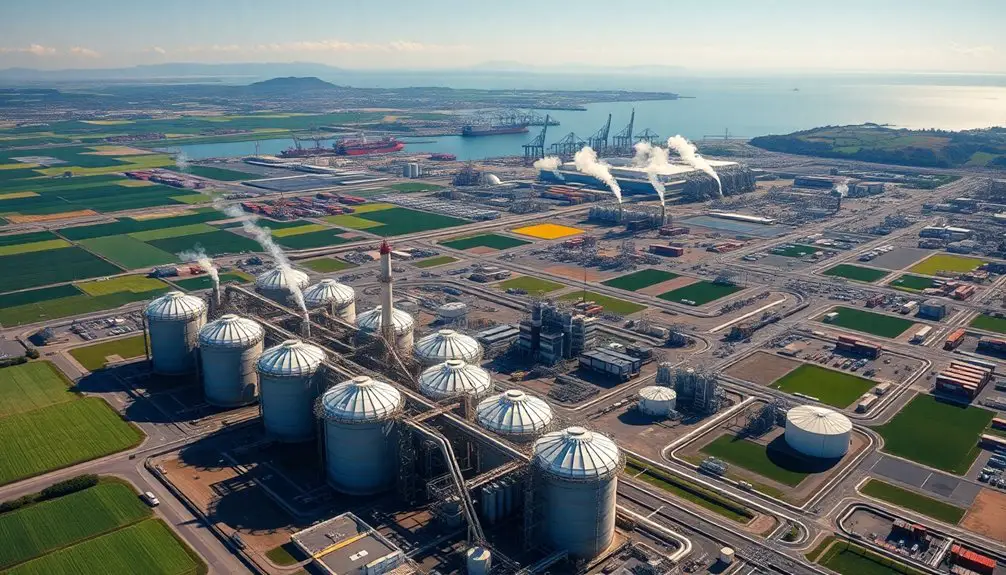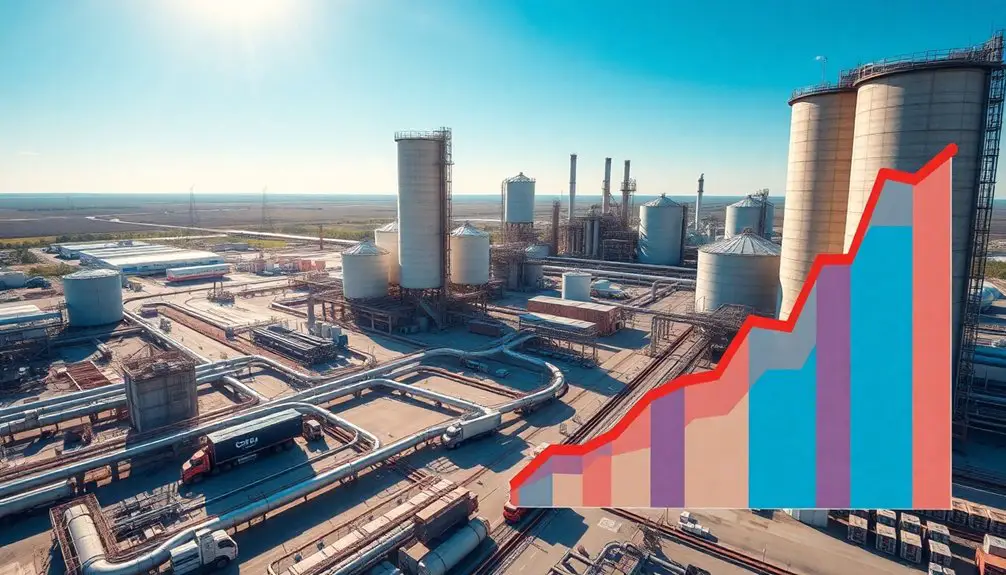In 2022, the global production of polypropylene hit around 86.74 million tons, highlighting its importance across multiple sectors. Asia Pacific dominated the market, capturing over 55% share due to rapid industrial growth in the region. Major producers like Braskem and ExxonMobil play crucial roles in this expanding market. With a projected annual growth rate of 5.35% from 2023 to 2028, demand for polypropylene is likely to rise further. Innovations in production and recycling processes will also influence future trends. There's a lot more to explore about this dynamic market and its environmental impacts ahead.
Key Takeaways
- Approximately 86.74 million tons of polypropylene were produced globally in 2022.
- The global production capacity reached around 97.86 million tons in 2022.
- The Asia Pacific region accounted for over 55% of global polypropylene production as of 2023.
- Future projections estimate a compound annual growth rate (CAGR) of 5.35% from 2023 to 2028.
- Key producers include Braskem, Reliance Industries, ExxonMobil, and Borouge, among others.
Global Polypropylene Production Statistics
Global polypropylene production statistics reveal a dynamic landscape marked by significant growth and demand. In 2022, global polypropylene production reached approximately 86.74 million tons, driven by strong demand from various sectors. The production capacity soared to around 97.86 million tons, indicating a robust infrastructure supporting the polypropylene market.
Major producers like Braskem, Reliance Industries, ExxonMobil, and Borouge play pivotal roles in this landscape, contributing significantly to the annual output.
As you look at the data, it's clear that the Asia Pacific region is a powerhouse, holding over 55% of the global market share in 2023. This dominance highlights the region's importance in the global polypropylene production scene.
Looking ahead, the polypropylene market is projected to expand further, with an expected growth rate of 5.35% CAGR from 2023 to 2028. This growth trajectory suggests that the demand for polypropylene will continue to rise, impacting the production landscape.
Key Drivers of Production Growth
The impressive growth in polypropylene production isn't just a coincidence; it's driven by several key factors. Understanding these elements helps you see why this material is booming in various industries.
- Automotive Industry Demand: The automotive sector has increasingly utilized polypropylene for lightweight and durable components, enhancing vehicle efficiency and performance.
- Packaging Needs: With rising demand for sustainable packaging solutions, businesses are turning to polypropylene for its versatility and recyclability, contributing significantly to production growth.
- Urbanization and Disposable Incomes: As urbanization accelerates and disposable incomes rise in developing countries, the demand for everyday products made from polypropylene surges.
Particularly in the Asia Pacific region, rapid industrialization and the growth of online shopping have heightened production needs.
Additionally, innovations in production technologies and advancements in recycling processes are making polypropylene production more efficient and sustainable.
The global push to reduce plastic waste, including the implementation of extended producer responsibility policies, also affects polypropylene production and drives companies to adopt more sustainable practices.
These factors combined create a robust environment for polypropylene production growth, ensuring its relevance in a rapidly evolving marketplace.
Regional Production Trends

Regional production trends in polypropylene reveal significant disparities across different areas of the world. In 2022, global polypropylene production capacity reached approximately 97.86 million tons, while actual demand was around 86.74 million tons. The Asia Pacific region stood out, capturing over 55% of the global market share in 2023, with China's rapid industrialization playing a pivotal role. Investments in new facilities and technologies have significantly boosted production capacity in this region.
North America is also experiencing growth, particularly in the food and beverage sectors, with projections indicating the U.S. market value could reach USD 12.07 billion by 2032. Meanwhile, Europe faces challenges, with fluctuating prices impacting production levels. However, new facilities, like Polimery Police in Poland, are enhancing regional production capacity.
| Region | Market Share (%) | Key Growth Areas |
|---|---|---|
| Asia Pacific | >55 | Industrialization, new technologies |
| North America | Growing | Food and beverage sectors |
| Europe | Fluctuating | New facilities amidst price fluctuations |
| China | Significant | Investments in production facilities |
These trends highlight the dynamic landscape of global polypropylene production.
Environmental Considerations
As polypropylene production expands to meet increasing demand, environmental considerations are becoming more pressing. The industry faces significant challenges that include:
- Greenhouse Gas Emissions: Traditional production methods contribute greatly to emissions, highlighting the need for sustainable production practices.
- Land and Water Pollution: Improper management can lead to severe environmental impacts, making environmentally friendly disposal methods essential.
- Recycling Initiatives: These initiatives are crucial for mitigating waste and promoting a circular economy, ensuring that materials are reused rather than discarded.
To address these issues, innovations in production technologies are emerging, such as the development of bio-based polypropylene. This move aims to reduce the environmental footprint associated with conventional methods.
Additionally, regulatory pressures are increasing, compelling the polypropylene industry to adopt greener practices and materials.
Embracing environmental responsibility is paramount for the sector's future. By focusing on sustainable production and actively participating in recycling initiatives, you can help lessen the environmental impacts of polypropylene. Furthermore, the global recycling rate standing at about 9% highlights the need for contamination reduction efforts to ensure recyclable plastics like polypropylene are properly processed.
The shift towards a more sustainable approach not only benefits the planet but also positions the industry to thrive in a world that increasingly values eco-friendly practices.
Future Production Projections

With global polypropylene production capacity reaching about 97.86 million tons in 2022, significant growth is on the horizon. Future production projections suggest that the annual production of polypropylene will see a remarkable increase, driven largely by rising consumer demand, especially in the Asia Pacific region. This area is witnessing rapid industrialization, which fuels the need for more versatile plastic materials. As consumers become more aware of the environmental impact of plastic, the demand for sustainable alternatives may also drive innovation in polypropylene production, focusing on biodegradable materials.
By 2028, the market value of polypropylene production is expected to hit approximately 159.66 billion USD, underscoring the sector's potential. The compound annual growth rate (CAGR) is projected at around 5.35% from 2023 to 2028, indicating a robust expansion trajectory.
Significant investments in new production facilities, like Nayara Energy's plant in Gujarat, India, are further poised to enhance global polypropylene production capabilities.
As you consider these trends, it's clear that adapting to the evolving market landscape will be crucial. Keeping an eye on upcoming production facilities and understanding consumer demand shifts will help you navigate the future of polypropylene effectively.
Embracing these developments will ensure you remain competitive in an increasingly dynamic industry.
Frequently Asked Questions
How Much Polypropylene Is Produced Annually?
You might find that polypropylene production varies yearly, but in 2022, it reached around 97.86 million tons. The market's expected to grow, with projections suggesting 114 million tons annually by 2030.
What Is the Global Production Capacity of Polypropylene?
You'll find that the global production capacity of polypropylene reached about 97.86 million tons in 2022. By 2028, it's expected to rise, driven by increasing demand and investments, especially in the Asia Pacific region.
How Much Polyethylene Is Produced Annually?
Each year, around 128 million tons of polyethylene is produced globally. As demand grows, especially in packaging and automotive sectors, you'll find major companies expanding their capacities to meet this increasing need for polyethylene.
Who Is the Largest Producer of Polypropylene?
You'll find that ExxonMobil is the largest producer of polypropylene. Their extensive facilities and strong market presence keep them at the forefront, alongside other major players like LyondellBasell, SABIC, and Borealis.

